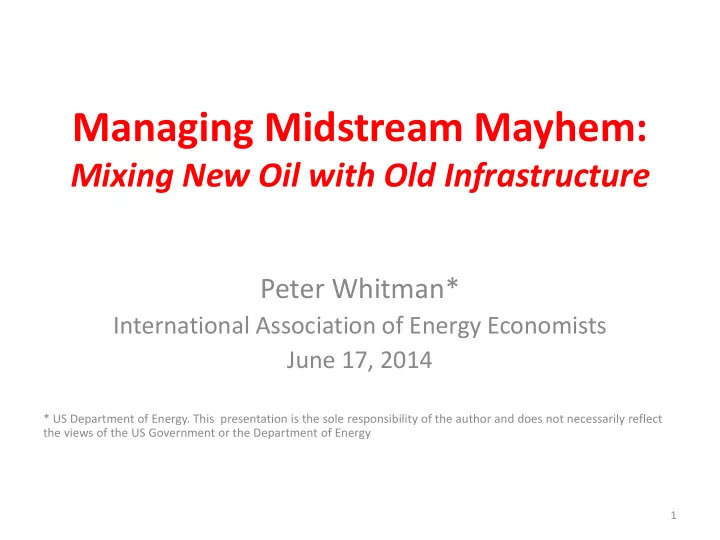

Managing Midstream Mayhem: Mixing New Oil with Old Infrastructure Peter Whitman* International Association of Energy Economists June 17, 2014 * US Department of Energy. This presentation is the sole responsibility of the author and does not necessarily reflect the views of the US Government or the Department of Energy 1
Outline Objectives Changing oil landscape will require additional infrastructure • Examine effect of lifting stylized oil export ban on flows • Methodology Least-cost production and transportation flow model of Atlantic Basin crude oil • supply and consumption at refining centers Develop representative refining model configurations and types • Derive refinery costs for changing crude slates by each refinery configuration • Detailed domestic crude infrastructure model with individual transportation • routes. Reduced form international nodes and routes Indicative Results and Conclusions Describe change in flows with increased domestic production • Methodology for change in refinery margins • 2
The Problem 3
Refinery Conversion Capability by Type 2012 Crude Utilization
Imports of Crude by PADD 2007 and 2012
Infrastructure Model Methodology Least-cost model: • Refinery economics modeling with Argonne National Laboratory and Jacobs o Consulting Refinery aggregations by refinery processing type (31 distinct refinery nodes) o Domestic infrastructure modeling with Oak Ridge National Laboratory o Tariffs and tanker rates o Develop representative refining model configurations and types • Unit characteristics derived from commercial applications o Gulf Coast heavy coking refinery o Gulf Coast light cracking refinery o Midwest heavy coking refinery o European representation o Aggregate refinery groups by throughput bottoms percent • Fraction of crude running through secondary processing units o Reflects amount of processing available to create high value products o Heavy crudes have higher bottoms percent; require more processing o 7
Detailed Methodology Methodology (continued) Detailed domestic crude infrastructure model with individual transportation routes. • Reduced form international nodes and routes Significant individual pipelines o Domestic barge and rail routes o Reduced form international nodes and routes o Key crude transportation routes: Africa, Europe , Latin America o EU refining node o Derive refinery costs and margin impacts for changing crude slates for each refinery • configuration Crude oil supply based on EIA’s Annual Energy Outlook o Domestic supply modeled by crude type: 5 crude streams by region (17 domestic regions) o International crudes relevant to the Atlantic Basin o Pooling, non-linear representation of blends, other standard refinery modeling techniques o Incorporate results of detailed refinery modeling through quantification of refining costs o due to changing crude slate Constraints on bottoms percent by refinery aggregate o 8
Key Design Metrics Crude Specifications Attribute Hvy Sour Med Sour Light Sour Hvy Med Sweet Lt Sweet API API<28 API 28-32 API>32 API<35 API>=35 Sul >.5 Sul >.5 Sul < .5 Sul < .5 Sul < .5 Sulfur Refinery Groups Base Domestic Production PADD 2012 Crude Production (MB/D) Average Number of Refinery Bottoms PADD Hvy Sour Med Sour Light Sour Hvy Med Sweet Lt Sweet Groups Percent 2 0 0 214 0 875 P1 3 16.23 3 63 706 573 23 2380 P2 12 17.18 4 0 49 61 0 257 P3 8 20.32 5 607 526 P4 3 18.42 669 1280 848 23 3513 P5 3 24.24 Total 29 - 9
Reference Case Crude Quality Consumption by Year PADD III Crude Types 3,500 Thousands of Barrels per Day 3,000 2,500 2012 2,000 2015 1,500 2020 1,000 500 - Hvy Sour Med Sour Light Sour Hvy Med Sweet Lt Sweet PADD II Crude Types 2,000 Thousands of Barrels per Day 1,800 1,600 2012 1,400 1,200 2015 1,000 2020 800 600 400 200 - Hvy Sour Med Sour Light Sour Hvy Med Sweet Lt Sweet 10
Reference Case Results Waterborne imports 7,000 6,000 Thousands of Barrels per Day 5,000 4,000 3,000 2012 2015 2,000 2020 1,000 0 11
High Resource Case Crude Quality 50% Lifted Export Ban 45% 40% 35% 30% 2012 25% 20% 2015 15% 2020 10% 5% 0% Hvy Sour Med Sour Light Sour Hvy Med Lt Sweet Sweet 50% Export Ban 45% 40% 35% 30% 2012 25% 2015 20% 15% 2020 10% 5% 0% Hvy Sour Med Sour Light Sour Hvy Med Lt Sweet Sweet 12
High Resource Case Waterborne Imports 3000 Thousands of Barrels per Day Lifted Export Ban 2500 2000 1500 2012 1000 2015 500 2020 0 3000 Thousands of Barrels per Day Export Ban 2500 2000 1500 2012 1000 2015 500 2020 0 13
Indicative Marginal Values No Price Feedback No Product Response Brent at $110 Selected Marginal Prices: No Feedback Refinery No Export Export $90 $96 Chicago_Refineries_Coking $96 $107 Ohio_Refineries $94 $103 Texas_3_Refineries_Bottoms_Conversion $96 $112 Texas_3_Refineries_Without_Bottoms_Conversion $110 $111 EC_Light_Refineries $104 $102 EC_Heavy_Refineries $95 $103 LA_AL_Bottoms_Conversion $96 $110 LA_AL_Without_Bottoms_Conversion 14
Conclusions Model shows increasing US production of light crudes, along with • increased Canadian production of heavy crudes could have a modest impact on US refining. Currently planned infrastructure along with rail could accommodate • changing crude flows under reference conditions The potential exists for exports to influence refinery economics and • producer wealth distribution Model shows relatively modest changes in refinery operations will likely • be necessary to accommodate a changed crude slate under reference forecasts, though profitability may very well be impacted. 15
Recommend
More recommend